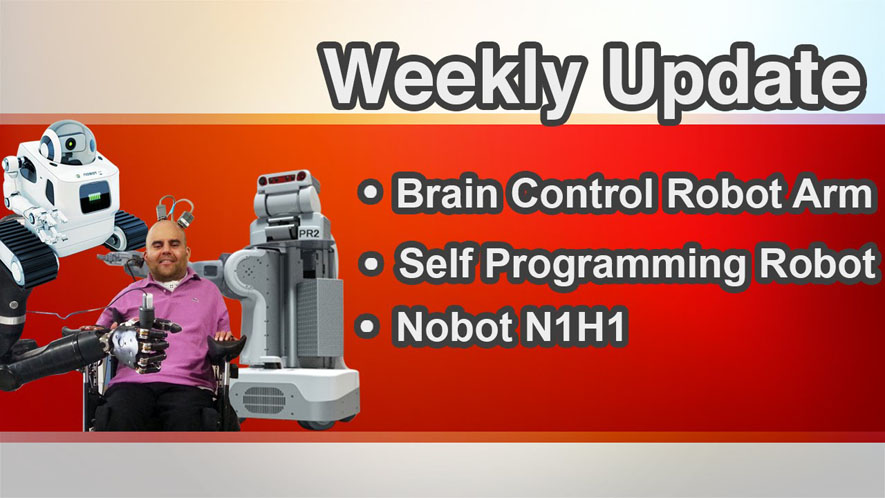Hi there, and welcome to my weekly Robot Update. This is wear I do a round up of what is going on in the Robot news around the world, so stay tuned.
Hi Guys, I’m Philip English from robophil.com, and welcome to the Robot Weekly update number 22.
Brain implants control robot arm
A paralyzed man named Erik Sorto has finally been able to drink beer on his own after 13 years, and it’s all thanks to a robotic arm controlled solely by his mind. Mind-controlled prosthetic limbs are nothing new, but they tend to be rather jerky in their movement, which severely limits what people can do with them. This is because most tap into the brain’s motor cortex – the part of the noggin used to direct physical actions. Professors at the California Institute of Technology took a different approach, relying not just on the motor cortex but also two implants consisting of 96 electrodes apiece: these implants are attached to the brain’s posterior parietal cortex (PPC), which plans physical movement rather than performing it. “The PPC is earlier in the pathway, so signals there are more related to movement planning: what you actually intend to do rather than the details of the movement execution,” said Richard Andersen, the James G. Boswell Professor of Neuroscience at CalTech.“”We hoped that the signals from the PPC would be easier for the patients to use, ultimately making the movement process more intuitive.“ For the patient who tried on the gear, the idea worked: he was able to direct the robot arm more precisely than other brain-controlled prosthetics. The subject could pick up a plastic cup of beer and drink it without quaffing*, shake hands smoothly, and play Rock, Paper, Scissors using fluid and precise movements. The next stage in the research is to work on the feedback mechanism from the arm back into the human brain, Andersen explained.
The $400 home robot that can be remotely controlled by cleaners an workmen
The dream of a home robot has been around ever since the Jetsons first hit TV screens.
However, rather than an automated machine doing your chores, one Dublin firm believes that humans will still be in control. They have revealed a remote controlled robot called Nobot (N1H1), that could act as a companion for the elderly, let workmen fix problems, and even clean your apartment and go and pick up dry cleaning. ‘We can combine the robot unit with a marketplace of operators so that every Nobot owner has a humanoid minion on tap, whenever they need one to do their bidding,’ the firm said, which is raising funds for the project on Indiegogo.
It hopes to release a range of robots that could carry out specialised tasks – acting as an electrician in a building, for instance. ‘’The core N1H1 unit is like someone dressed up as a robot, except they can be anywhere in the world and the Nobot is right beside you, or off doing an errand at your bidding. Although most firms are developing artificially intelligent robots, Nobot says its project is far more realistic. The firm also hopes to work with home appliance makers to allow the nobot to control them.
Scientists trains robot to learn new tasks like humans
Scientists have developed new algorithms that enable robot to learn motor tasks through trial and error – much like human learn new tasks, marking a major milestone in artificial intelligence.
Researchers demonstrated their technique, a type of reinforcement learning, by having a robot complete various tasks – putting a clothes hanger on a rack, assembling a toy plane, screwing a cap on a water bottle, and more – without preprogrammed details about its surroundings. “What we’re reporting on here is a new approach to empowering a robot to learn,” said Professor Pieter Abbeel of University of California, Berkeley’s Department of Electrical Engineering and Computer Sciences. “
The key is that when a robot is faced with something new, we won’t have to reprogramme it. The exact same software, which encodes how the robot can learn, was used to allow the robot to learn all the different tasks we gave it,” said Abbeel. The researchers turned to a new branch of artificial intelligence known as deep learning, which is loosely inspired by the neural circuitry of the human brain when it perceives and interacts with the world. In the experiments, the researchers worked with a Willow Garage Personal Robot 2 (PR2), which they nicknamed BRETT, or Berkeley Robot for the Elimination of Tedious Tasks. They presented BRETT with a series of motor tasks, such as placing blocks into matching openings or stacking Lego blocks.
That’s it guys, for a weekly world Robot News, I am your host Philip English
If you like this weekly report and want to see more of the latest Robot News, Reviews and robotic tutorials, then please hit the subscribe button, to keep up to date
I have put further information about the robots in the weekly robot update in the links below, as well as extra webs link for your review.
If you have a robot product that you would like me to do a review or do a tutorials for, then please ping me over a message in the comments section and I will see what I can do.
Thanks Guys! I looking forward to see you next time.
Philip English: https://philipenglish.com
Sponsor: Robot Center: http://www.robotcenter.co.uk

